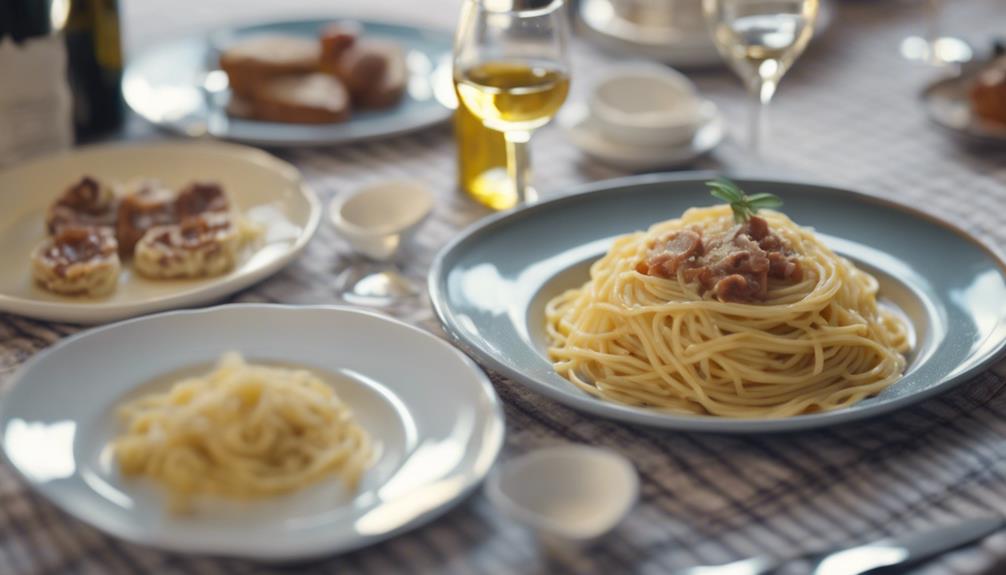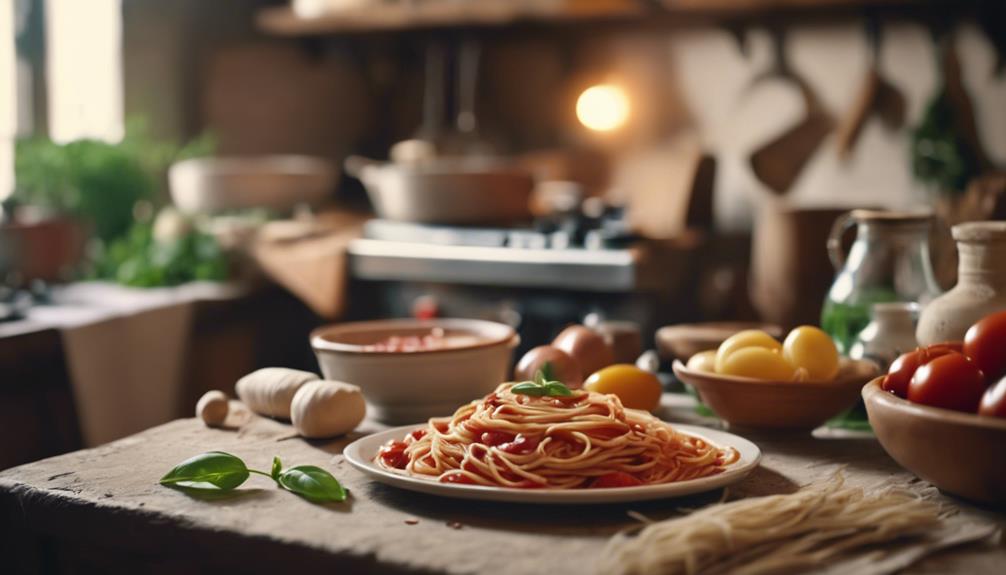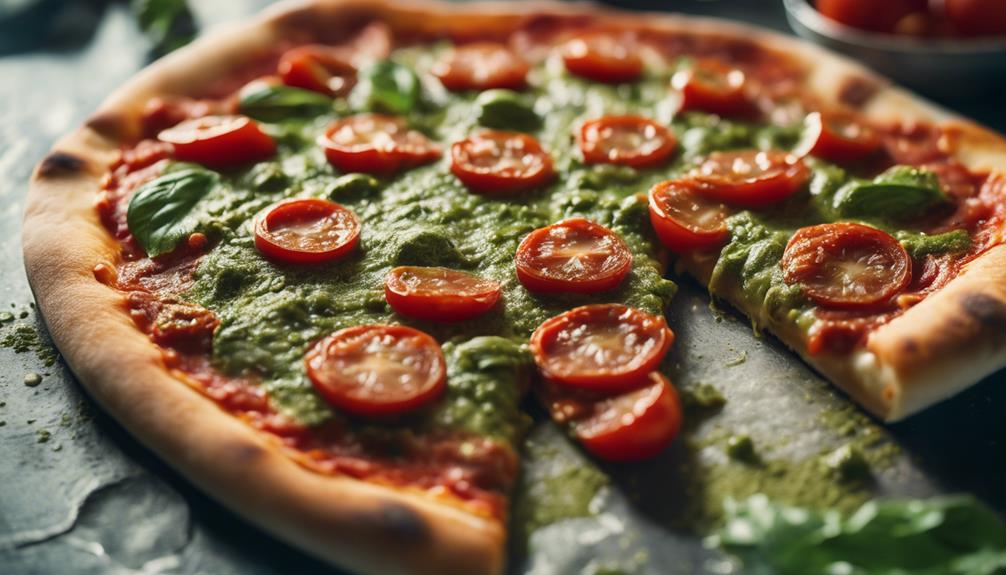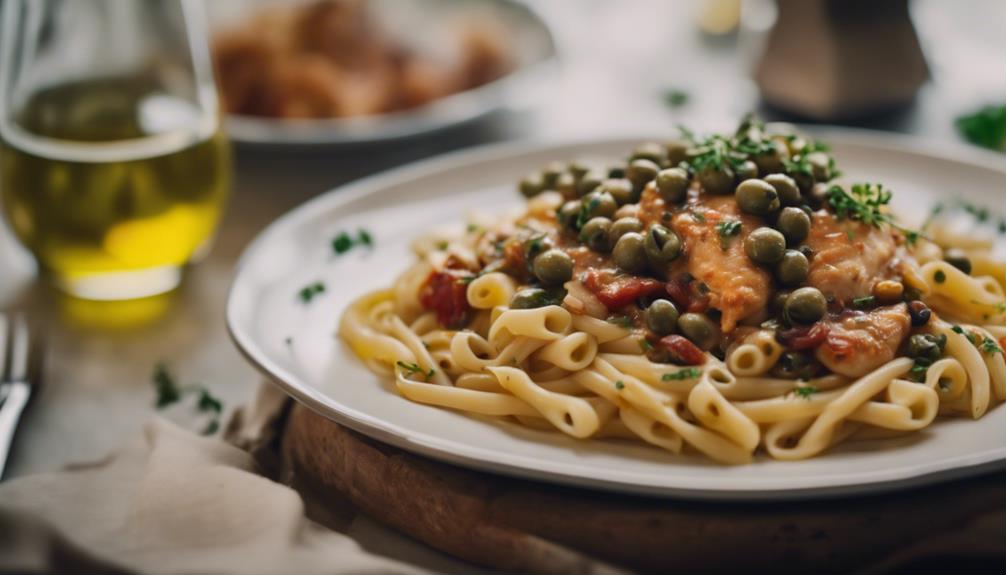If you are interested in trying some authentic Italian cuisine, you are in for a delicious experience! Treat yourself to pasta dishes such as Tagliatelle al ragù and Rigatoni alla carbonara. Sample creamy risotto options like Risotto alla Milanese and Risotto ai Funghi. Start off with antipasti featuring cured meats and cheeses for a flavorful beginning. Explore classic entrees like Trofie al pesto and Bombolotti all’Amatriciana filled with regional flavors. Finish your meal with traditional desserts like Gelato and Tiramisù. These dishes highlight Italy’s culinary traditions with a modern flair, ensuring a delightful gastronomic journey.
Key Takeaways
- Tagliatelle al ragù, Lasagne, Risotto alla Milanese, Antipasti, Pizza Margherita are traditional Italian dishes.
- Pasta specialties like Trofie al pesto and Bombolotti all'Amatriciana showcase regional flavors.
- Classic desserts like Gelato, Tiramisù, and Sfogliatella complement main courses.
- Parmigiano Reggiano, Pecorino Romano, and Mozzarella di Bufala are popular Italian cheeses.
- Local ingredients like tomato sauce and seafood mix define authentic Italian cuisine.
Pasta Specialties
Explore the rich variety of traditional Italian pasta specialties that showcase regional flavors and culinary expertise. From the iconic Tagliatelle al ragù to the creamy Rigatoni alla carbonara and the fresh Trofie al pesto, Traditional Italian cuisine is a treasure trove of pasta dishes that delight taste buds worldwide.
Lasagne with layers of rich ragù and béchamel sauce, along with the flavorful Bombolotti all'Amatriciana, are just a few examples of classic Italian favorites that have stood the test of time.
Italian pasta, originating in Sicily, has evolved into a culinary masterpiece with countless shapes, sizes, and sauce variations. This staple of Italian cuisine reflects the country's diverse culinary landscape, offering endless pasta options with unique ingredients, techniques, and flavors.
Each region in Italy takes pride in its traditional pasta recipes and methods of preparation, adding to the rich tapestry of flavors that make Italian cuisine so beloved worldwide.
Risotto Varieties

Explore the diverse array of risotto varieties that form an integral part of Northern Italian cuisine. When it comes to risotto, Arborio rice takes the center stage, renowned for its creamy consistency that melds perfectly with various flavors.
- Risotto alla Milanese: This classic dish is infused with the luxurious aroma and vibrant color of saffron, adding a touch of elegance to the creamy rice.
- Risotto ai Funghi: For mushroom lovers, this variation offers a delightful mix of earthy flavors, making it a comforting and hearty choice.
- Primo Perfection: Risotto is often served as a primo, a traditional first course in Italian meals. This allows you to savor the slow-cooked goodness and appreciate the constant stirring that yields its signature creaminess.
Each plate of risotto tells a story of meticulous preparation, where the gradual addition of broth and cheese creates a rich and savory delight. With each region adding its unique twist, risotto continues to be a beloved dish that showcases the culinary diversity of Italy.
Antipasti Selections
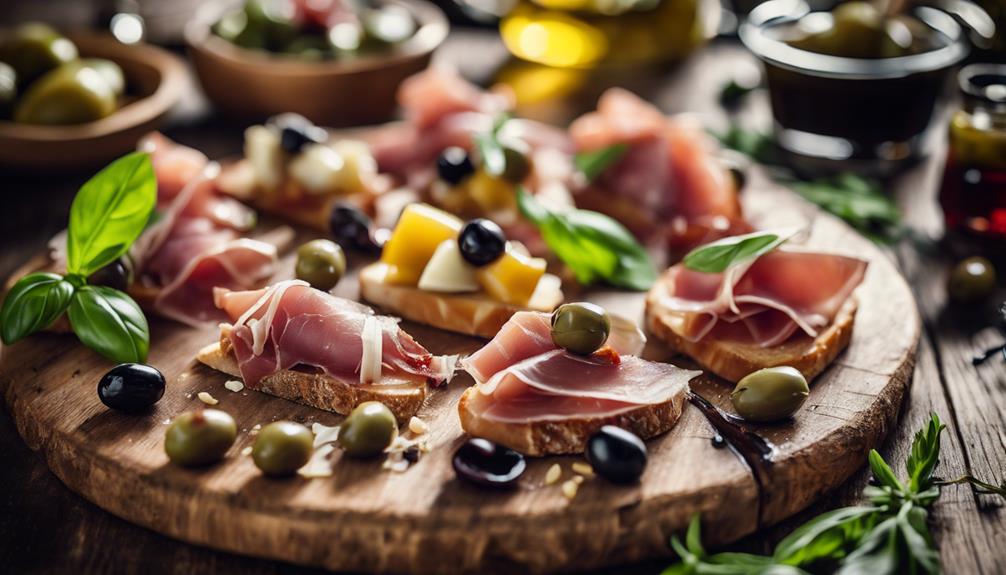
Let's now shift our focus to the delectable array of antipasti selections, traditional Italian starters that tantalize the taste buds before the main course.
Antipasti, meaning 'before the meal' in Italian, are more than just appetizers – they're a celebration of flavors and textures that set the stage for the culinary experience to come. Typically featuring a variety of cured meats, cheeses, olives, and marinated vegetables, antipasti showcase the freshest ingredients and regional specialties of Italy.
From the salty bite of prosciutto to the creamy richness of buffalo mozzarella, these starters offer a glimpse into the diverse and vibrant food culture of the country.
When indulging in antipasti, remember that they're meant to be shared and enjoyed with friends and family, encouraging a sense of conviviality and togetherness before the main meal.
Classic Main Courses
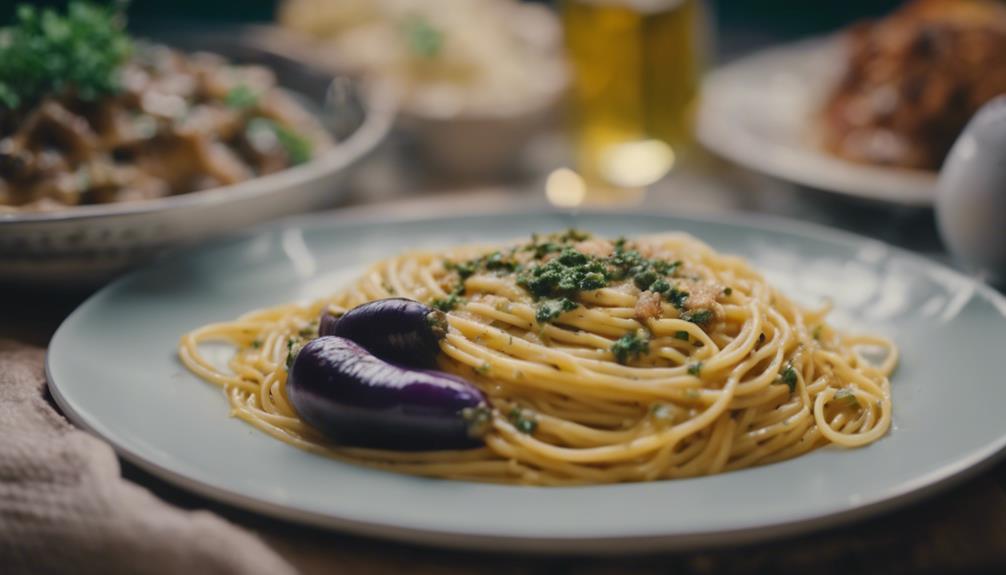
Explore the world of traditional Italian cuisine with a selection of classic main courses that showcase regional flavors and ingredients. Indulge in these iconic dishes that have stood the test of time:
- Tagliatelle al ragù: Hail from Emilia Romagna and savor the combination of fresh pasta coated in a rich pork, beef, and red wine ragù sauce, creating a savory masterpiece.
- Trofie al pesto: Transport yourself to Genoa with this dish featuring fresh pasta twisted with a vibrant pesto sauce made from basil, Parmigiano Reggiano cheese, and pine kernels, delivering a burst of flavors in every bite.
- Bombolotti all'Amatriciana: Let your taste buds dance with this Roman delight, where bombolotti pasta meets the bold flavors of Amatriciana sauce, crispy pork cheek, and Roman pecorino cheese, promising a culinary adventure.
These classic main courses not only offer a glimpse into Italy's diverse culinary landscape but also provide a truly authentic dining experience that will leave you craving more.
Authentic Desserts

Indulge in a sweet culinary journey through Italy by exploring the array of authentic desserts that perfectly complement the richness of classic main courses. Italian desserts are renowned for their decadent flavors and exquisite textures. Below is a table highlighting some of the most beloved Italian desserts:
| Dessert | Description |
|---|---|
| Gelato | Creamy and rich traditional Italian ice cream, with classic flavors like pistachio and hazelnut. |
| Tiramisù | A popular dessert originating from the Veneto region, made with coffee-soaked ladyfingers and mascarpone cheese. |
| Sfogliatella | Neapolitan pastry filled with sweet ricotta cheese, available in curly or smooth varieties. |
| Insalata Caprese | A simple Italian salad made with fresh tomatoes, mozzarella cheese, basil, olive oil, and balsamic vinegar. |
These desserts offer a delightful conclusion to any Italian meal. Whether you have a penchant for the creamy indulgence of Gelato, the rich layers of Tiramisù, the flaky goodness of Sfogliatella, or the invigorating simplicity of Insalata Caprese, Italian desserts are sure to satisfy your sweet tooth and leave you craving for more.
Regional Flavors
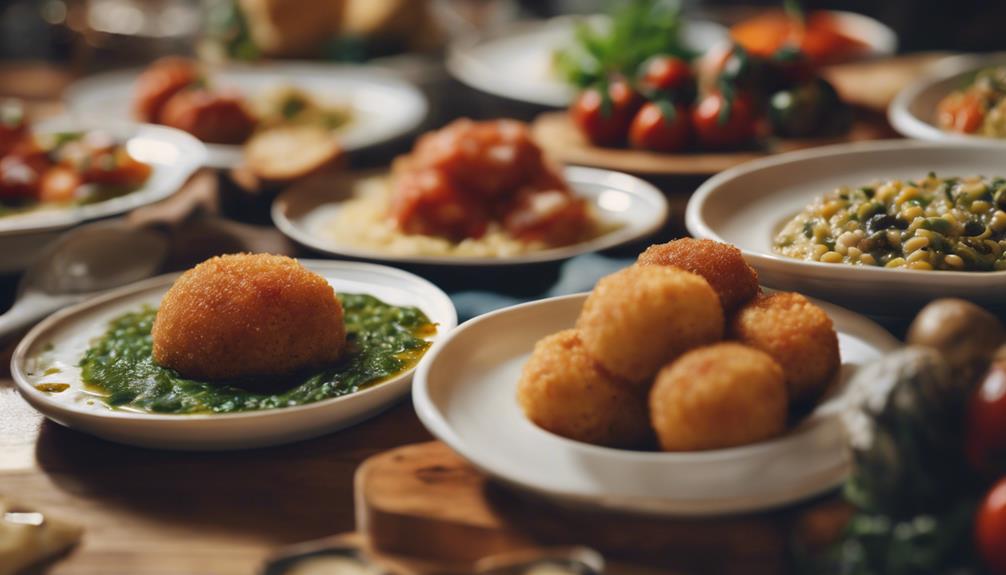
When it comes to traditional Italian dishes, the regional flavors truly shine through. From the seafood mix of Brodetto in Vasto to the sweet and sour notes of Sicilian Caponata, each region boasts its own culinary delights.
Get ready to explore diverse regional specialties, culinary influences, and history, all centered around signature local ingredients that make Italian cuisine so unique and delicious!
Diverse Regional Specialties
From Vasto's Brodetto to Sardinia's Malloreddus alla Campidanese, traditional Italian dishes showcase a rich tapestry of diverse regional specialties bursting with unique flavors.
- Vasto's Brodetto: This seafood mix hails from the Adriatic coast, highlighting the bounty of the sea in Italian food.
- Emilia Romagna's Tortellini: Indulge in this handcrafted pasta stuffed with a delicious blend of pork loin, ham, and Parmigiano cheese, a true regional classic.
- Sicily's Caponata: Experience the sweet and sour flavors of this Sicilian dish, where potatoes, eggplant, and bell peppers come together in a tantalizing concoction.
Each region of Italy boasts its own culinary treasures, from the hearty Piedmontese specialty of Bollito alla Piemontese with its boiled meats and bittersweet sauces to the unique Sardinian dish Malloreddus alla Campidanese, featuring shell-shaped pasta and flavorful sausage ragù.
These diverse regional specialties not only offer a taste of authentic Italy but also reflect the rich history and culinary traditions that make Italian cuisine so beloved worldwide.
Culinary Influences and History
Italian cuisine's regional flavors are deeply influenced by diverse landscapes, climates, and cultural histories. Each of Italy's regions boasts a unique culinary identity, with traditional dishes reflecting the local customs and ingredients specific to that area. From the hearty risottos of the north to the fresh seafood dishes of the south, the authenticity of Italian cuisine lies in the regional flavors that have been preserved for generations.
To give you a taste of the culinary influences across Italy's regions, here is a table showcasing some traditional dishes:
| Italian Region | Traditional Dish |
|---|---|
| Lombardy | Risotto alla Milanese |
| Sicily | Pasta alla Norma |
| Tuscany | Ribollita |
| Campania | Spaghetti alle Vongole |
| Piedmont | Vitello Tonnato |
These dishes not only represent the diverse flavors of Italy but also highlight the importance of using high-quality ingredients like olive oil, tomatoes, and Parmesan cheese to create authentic Italian flavors.
Signature Local Ingredients
Explore the rich tapestry of regional flavors in Italian cuisine through the signature local ingredients that define traditional dishes across Italy's diverse culinary landscape.
When it comes to Italian cuisine, signature local ingredients play an essential role in creating the authentic flavors that make each region's dishes unique.
Here are some key ingredients that shine in traditional Italian dishes:
- Parmigiano Cheese: Hailing from Emilia Romagna, this cheese is a staple in dishes like tortellini, adding a rich and savory flavor profile.
- Tomato Sauce: An indispensable component in many pasta dishes like spaghetti, the vibrant and tangy tomato sauce brings a burst of freshness to the plate.
- Seafood Mix: Found in dishes like Brodetto from Vasto, the seafood mix captures the essence of the Adriatic coast with its briny and flavorful seafood medley.
Signature local ingredients not only define the taste of traditional Italian dishes but also showcase the culinary diversity and richness of Italy's gastronomic heritage.
Italian Pizza Variations

Discover the diverse array of traditional Italian pizza variations, each boasting unique flavors and toppings that reflect the rich culinary tradition of Italy. From the classic Margherita, with its vibrant tomato sauce, fresh mozzarella cheese, and fragrant basil leaves, to the savory Marinara, served with a tangy tomato base, aromatic garlic, oregano, and a drizzle of olive oil, Italian pizzas offer a delightful range of flavors.
The Quattro Stagioni pizza takes it a step further by dividing the pie into four sections, each representing a different season with complementary toppings, showcasing the creativity of Italian pizza makers.
Cooked to perfection in wood-fired ovens, these pizzas achieve a crispy crust and gooey melted cheese that elevate the dining experience. It's no wonder that each region in Italy has its own unique pizza styles and toppings, reflecting the diverse culinary heritage of the country.
Traditional Cheese Delights
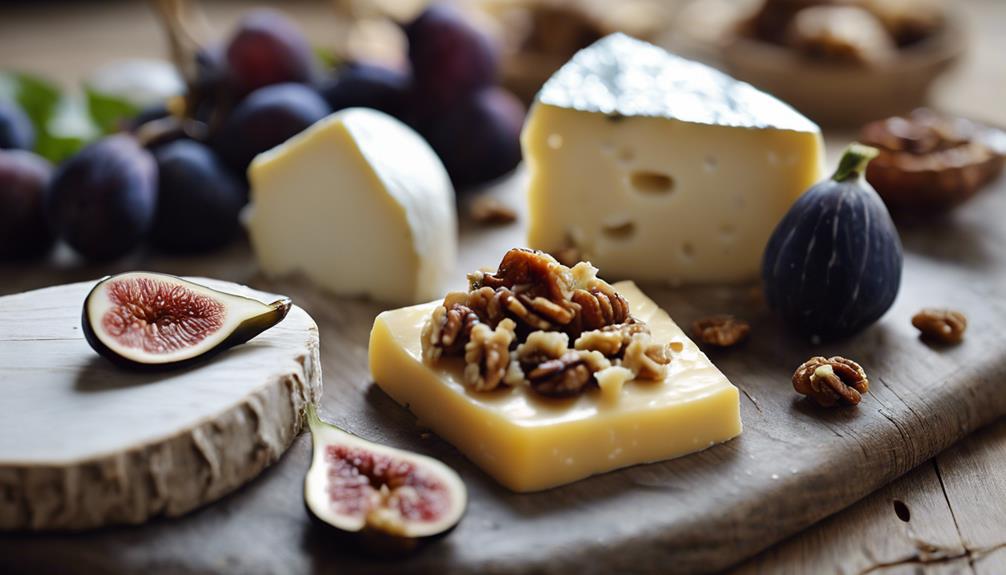
Get ready to tantalize your taste buds with a journey through Italy's cheese delights.
From the classic Ricotta-filled Cannoli to the creamy Gorgonzola Dolce, there's a cheese for every palate.
Explore popular pairings and regional specialties that will elevate your culinary experience to a whole new level.
Classic Cheese Varieties
Delighting taste buds with their rich flavors, traditional Italian cheese varieties like Parmigiano Reggiano, Pecorino Romano, Mozzarella di Bufala, Gorgonzola, and Taleggio are staples in classic Italian cuisine. These cheeses offer a delightful range of textures and tastes that elevate any dish they're added to.
Here are three classic Italian cheese varieties to tantalize your taste buds:
- Parmigiano Reggiano: Known as the 'King of Cheeses,' this hard, granular cheese boasts a rich, nutty flavor that enhances pasta dishes and risottos.
- Pecorino Romano: A sharp and salty sheep's milk cheese, Pecorino Romano adds a bold kick to classic Italian dishes like pasta carbonara and cacio e pepe.
- Mozzarella di Bufala: This fresh, soft cheese made from water buffalo milk is perfect for creating the iconic Caprese salads and authentic Neapolitan pizzas, bringing a creamy texture and mild flavor to the table.
These classic Italian cheeses play a significant role in enriching the culinary experience and are a must-try for cheese enthusiasts.
Popular Cheese Pairings
Enhancing the flavors of traditional Italian cheeses, exploring popular cheese pairings offers a delightful culinary experience. Parmigiano Reggiano, known as the 'King of Cheeses,' finds its match in balsamic vinegar and honey, creating a delightful sweet and savory contrast that tantalizes the taste buds.
Gorgonzola cheese, with its bold and creamy flavor, pairs exquisitely with the sweetness of pears and the crunch of walnuts in a classic Italian salad or antipasto. Pecorino Romano, a sharp and salty cheese, harmonizes beautifully with the sweetness of honey or fig spread, creating a delightful balance of flavors.
Taleggio cheese, with its rich and creamy texture, shines on a charcuterie board alongside slices of prosciutto and crusty bread, offering a decadent indulgence. Grana Padano cheese, a staple in Italian cuisine, is perfect for grating over pasta dishes like risotto or carbonara, adding a nutty and salty dimension that elevates the dish to new heights.
Experimenting with these popular cheese pairings opens up a world of delicious possibilities for your next culinary adventure.
Regional Cheese Specialties
Discovering the diverse regional cheese specialties of Italy reveals a rich tapestry of traditional cheese delights that showcase the unique flavors and heritage of each area.
- Pecorino Romano from Lazio: Known for its sharp and salty taste, this sheep's milk cheese is a staple in Roman cuisine, perfect for grating over pasta dishes.
- Parmigiano Reggiano from Emilia Romagna: Often called the 'King of Cheeses,' this hard, granular cheese is aged for a minimum of 12 months, offering a nutty and savory flavor that enhances risottos and salads.
- Gorgonzola from Lombardy: A creamy blue cheese with a distinctive sharpness, Gorgonzola is a versatile cheese that can be enjoyed on its own, crumbled over salads, or melted into sauces.
Italy's cheese traditions extend beyond these renowned varieties to include Asiago from Veneto, Taleggio from Lombardy, and many more, each contributing to the rich tapestry of Italian culinary heritage.
Seafood Delicacies
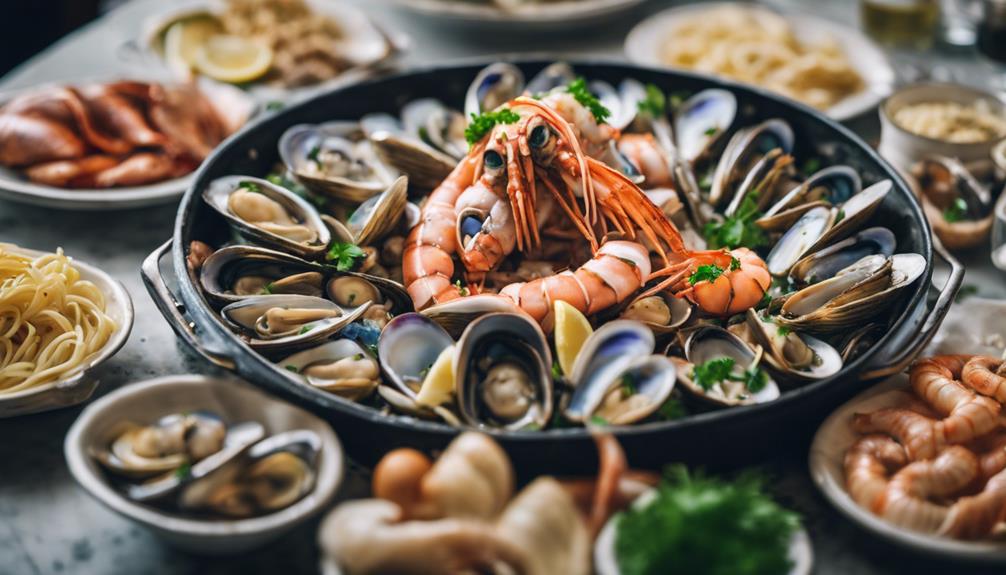
Seafood holds a central place in traditional Italian cuisine, featuring a rich array of flavorful delicacies showcasing the bounty of the Mediterranean Sea. Italian seafood dishes commonly include a delightful mix of shrimp, mussels, sardines, squid, and cod, each contributing to the vibrant tapestry of flavors that define Italian gastronomy.
One renowned Italian seafood delicacy is linguine allo scoglio, a delectable dish brimming with calamari, clams, mussels, shrimp, and prawns, offering a true taste of the sea.
In Italian culture, seafood plays a significant role, often taking center stage in festive gatherings like the cherished seafood feast on Christmas Eve. This tradition transcends into Italian-American cuisine, where a fusion of Italian and American flavors gives rise to a plethora of seafood delights.
In Italian-American households, enjoying a seafood feast isn't just a meal but a celebration of heritage and culinary excellence, highlighting the enduring importance of seafood in both Italian and Italian-American culinary traditions.
Frequently Asked Questions
What Are 5 Traditional Italian Dishes?
You'll enjoy classic Italian dishes like tagliatelle al ragù, rigatoni alla carbonara, trofie al pesto, lasagne, and bombolotti all'Amatriciana. Simultaneously, savor the pork, beef, red wine ragù, raw egg, pork cheek, basil, bolognese sauce, and more!
What Are the Top 10 Italian Dishes?
Imagine embarking on a culinary tour through Italy's finest flavors. Explore the top 10 Italian dishes that tantalize your taste buds with rich history and diverse ingredients. Let these iconic recipes transport you to the heart of Italian cuisine.
What Are Italian Main Dishes?
Italian main dishes showcase regional flavors and culinary traditions. They include classics like Tagliatelle al ragù, Rigatoni alla carbonara, Trofie al pesto, Lasagne, and Bombolotti all'Amatriciana. These dishes feature a variety of ingredients for a delicious experience.
What Is Italy's National Dish?
Oh, the great national dish debate! Italy doesn't officially have one, but pasta reigns as a culinary icon. The regional diversity of dishes like pasta, pizza, and gelato proudly showcases Italy's gastronomic prowess.
Are Traditional Italian Dishes and Authentic Italian Dishes the Same?
Yes, traditional Italian dishes and authentic Italian dishes are often the same. Authentic Italian dishes are those that originate from Italy and are made using traditional recipes and methods. These dishes showcase the true flavors and ingredients of Italian cuisine, making them truly authentic Italian dishes.
Conclusion
To sum up, traditional Italian dishes offer a flavorful journey through the diverse regions of Italy. From the rich pasta specialties to the delicate seafood delicacies, each dish tells a story of tradition and passion.
So next time you sit down to enjoy a plate of authentic Italian cuisine, remember that you aren't just eating a meal, but experiencing a piece of Italian culture on your plate.
Bon appétit!
